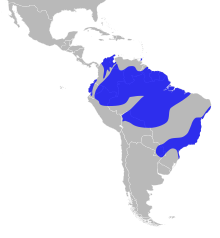Saber pipra
| Saber pipra | ||||||||||||
|---|---|---|---|---|---|---|---|---|---|---|---|---|

Male saber pipra |
||||||||||||
| Systematics | ||||||||||||
|
||||||||||||
| Scientific name | ||||||||||||
| Manacus manacus | ||||||||||||
| Linnaeus , 1766 |
The Säbelpipra ( Manacus manacus ), also Weißsäbelpipra or monk Manakin called, is a 9.5 to 11. centimeter kind from the family of Manakin .
Appearance
The male of this species has a black back and black wings. The top of the tail and the top of the head are also black. The beak is silver, the legs are orange. The abdomen, throat, and most of the head are white. The female is colored in a simple olive green.
Distribution and way of life
This species occurs in the forests of tropical South America from Trinidad to northeast Argentina . It inhabits the local forests as well as the river banks and the forest edges. They eat fruits, which they tear or peck from the branches in flight. In addition, insects are also captured in flight. The birds stay true to their location all year round.
Reproduction
Smaller groups of up to 50 animals can be found together for reproduction. For courtship, the males set up a circle with a diameter of about one meter as an arena, away from the vegetation. Here they draw attention to themselves from afar with bright calls and a bang reminiscent of fireworks. To impress the females, they perform dances with fluffed plumage. With the wing feathers of their wings they create sounds. They leave the nest building, the hatching of the clutch and the rearing of the young to the females alone. The males usually mate with several females. The female lays only two white eggs in a bowl-shaped nest, which is built in bushes at a height of 0.5–2 meters above the ground. The incubation period is 17–21 days. The young do not fledge until they are 14 days old. The young are supplied with insects. The saber pipra has a year-round breeding season.
Hazards and protective measures
Because of its wide distribution and that no endangerments are known for this species, the IUCN classifies this species as ( Least Concern ) not endangered.
literature
- Christopher M. Perrins : The Great Encyclopedia of Birds. From the English, Orbis-Verlag, Munich 1996, ISBN 3-572-00810-7 , pp. 231, 233.
- David Burnie (Ed.), Mariele Radmacher-Martens: Animals: The large picture encyclopedia with over 2,000 species. Translated from the English by Gabriele Lehari. Dorling Kindersley, Munich 2012, ISBN 978-3-8310-2232-8 , p. 347.
- Jiří Felix (ed.), Alena Čepická: America's fauna in color. Translated from the Czech by Jaroslav Konšal. Karl Müller Verlag, Erlangen 1989. pp. 68-69.
Web links
- Manacus manacus inthe IUCN Red List of Threatened Species 2017.1. Listed by: BirdLife International, 2016. Retrieved May 27, 2017.

